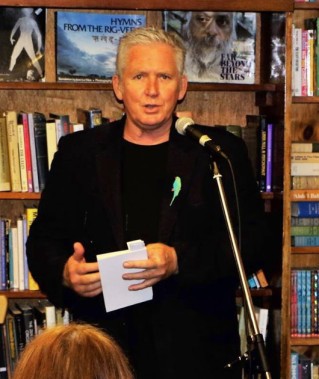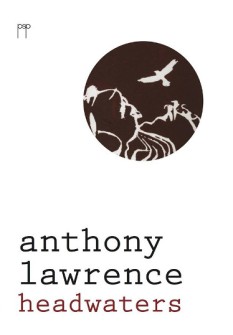Headwaters by Anthony Lawrence, Pitt Street Poetry 2016, was launched by Mark Roberts at The Press Book House, Hunter Street Newcastle on 2 April as part of the 2016 Newcastle Writers Festival.

It is a great privilege to be here this afternoon to launch Headwaters, Anthony’s 15th (I think) book of poetry, at the 2016 Newcastle Writers Festival. Anthony is one of those poets whose work I have known and respected for decades and whose work has been a great influence on my own work. His first book, Dreaming in Stone, was published in 1989 and, like an alluvial river flood, each of those previous books has added another layer of richness to Australian poetry and to Australian culture.
Headwaters is no exception – it is a particularly rich and complex layer that is washing over us today. It is, afterall, a book that could probably launch itself. When I first picked it up it fell open at a poem called ‘The Deep’ which begins:
Crossing the bar from river to open ocean
had become a metaphor we’d devised
for separation, for moving on
so we learned to navigate by intuition
finding ourselves together and alone
beyond sight of land, where distance
and direction are defined by closure…
What need is there of an introduction after lines like these? A simple, beautiful image, the metaphor announced from within the poem easing us into the complexity to come. This is a poem of extremes – The opening image of the bar separating the river from ocean is at the end of the river which has its source in the “headwaters” of the book’s title. The river and ocean, the land and water and most importantly, light and dark. Here Anthony references the photic and abyssal layers of the oceans – photic where light can penetrate and abyssal where the ocean is so deep no light can reach and which is in perpetual darkness.
Once again what powerful imagery we have here – a free diving couple entering the “fatal levels”. Of course there are many depths to this poem, it is wonderfully descriptive, but we are also told, in the second line, to read it as a metaphor – so we have “signal stations of remorse” and marker bouys “tethered loosely on a line”. To find out just how deep this poem goes you will have to buy the book but, rest assured, you will not be disappointed.
For the past few months I have become fascinated with a word – not a unique experience for a poet I guess, but the word has stuck with me and provided me with a tool to explore some of my favourite poets and poems – that word is ‘lacuna’ and, according to the Oxford Dictionary it means:
“An unfilled space; a gap” or “A missing portion in a book or manuscript” and finally in anatomy “a cavity or depression, especially in bone”
 What a wonderful word and what poetic meanings. This notion of a gap or an unfilled space is an important one for an artist, a gap suggests possibilities, untold stories, connections to be made, a space for the imagination. A good poet can find these gaps and spaces, recognise them when even when they hard to find or even seemingly non existent, but they have to also be able to make the connections and fill those spaces with poetry that makes us stop and wonder at what has been discovered. Fortunately for us Anthony brings this skill to Headwaters and we have the pleasure of watching the gaps and spaces open up and of seeing them filled with poetry.
What a wonderful word and what poetic meanings. This notion of a gap or an unfilled space is an important one for an artist, a gap suggests possibilities, untold stories, connections to be made, a space for the imagination. A good poet can find these gaps and spaces, recognise them when even when they hard to find or even seemingly non existent, but they have to also be able to make the connections and fill those spaces with poetry that makes us stop and wonder at what has been discovered. Fortunately for us Anthony brings this skill to Headwaters and we have the pleasure of watching the gaps and spaces open up and of seeing them filled with poetry.
‘Murmuration’ is one such poem. I read the title and loved the word without really understanding what it meant. I thought of the soft murmur of voices, of a conversation that you can just hear but can’t make out the words, that rises and falls in tones and which you think you may almost understand from the pattern of sounds rather than the hearing of words. But within a few lines I knew I was mostly mistaken:
The first two syllables of the word
that defines the way starlings take a spiral apart
only to fly it back together
…………..is also the sound of rain
………………………..falling over the Pantheon
or through miles of telegraph poles
on the Monaro Plain
“Murmuration” then is the pattern starlings make as they fly in large groups when they move almost as one. Not for the first time I am driven to research, Anthony has discovered this gap, this space I did not know of until I started reading this poem and now the opening lines have me diving into Current Biology Vol 22 Issue No 4 (and here I quote):
Collections of animals have been given some of the most fanciful, and sometimes unusual, nouns. ……. Tuneful finches are known as a charm, whilst corvids do less well: collections of crows and ravens are known as a murder or an unkindness, respectively. One of the most stunning examples of collective behaviour is the spectacular display of European starlings, the noun for which is a murmuration
By the way I can thoroughly recommend Andrew J. King and David J.Sumpter’s article on Murmuration if you want to really get into Anthony’s poem.
The poem has this mass movement, an aerial ballet if you like, seemingly choreographed yet spontaneous. At the same time, it celebrates the sound of the word that describes this movement, the gentle sound like rain falling over the Pantheon or through wires strung across the Monaro Plains. So there was some intuitive logic and even meaning to my initial thoughts on the meaning of Murmuration.
– A Starling Murmuration
.
Anthony has now, however, sent me off in search of Murmurations and I discovered pages and pages of YouTube videos of flocks of starlings forming the most amazing patterns, moving backwards and forwards across the sky. You see he has opened up a space, a gap that I didn’t even know existed and he has filled it with wonderful imagery.
Often the imagery and strength of Anthony’s poems can hide the beauty of the poem’s structure, but it is worth paying some attention to how the poems in this volume are crafted. Anthony has chosen the structure of individual poems carefully and it is clear, when we look at the poems on the page, that much thought has gone into the way they sit on the page, on the line indents, the white space around the poems and the actual stanza and line breaks. He seems particular fond of tercets, the three line stanzas serve him well both in shorter and longer poems, and there are variations on this structure, with three line indents replacing stanza breaks in poems such as ‘Lies’ and a slightly different structure in ‘Expectation’. There is a another variation in the longer poem ‘Taxonomy’ with every third line broken by a middle justified line, a structure that supports a quite amazing poem very well.
And of course I can’t end without acknowledging the physical beauty of book as artifact – from its beautiful front cover featuring a stunning wood cut by Julie Manning, to the design and production of the book – the look and feel of the book if you like. We must congratulate the publishers, Pitt Street Poetry, of course, for bringing together such a fine production. To be a poetry publisher in Australia is a commitment of love, perhaps the 21st century version of Dransfield’s “Ultimate Committment” . It is a love of poetry and a commitment that art, and in particular poetry, has to be an important part of our lives, both individually and as a society. Pitt Street Poetry, and all other publishers that make that commitment, deserve to be supported – without them it would be much, much harder to find work like the extraordinary poems we are launching today.
This is a book that you will want to carry around with you for days. Read it through once and then return to it again and again. The poems will open up, you will find spaces that you didn’t even know existed filled with wonderful imagery and layered meanings – a tonic for this ‘always on’, instant gratification culture which surrounds us today.
So congratulations Anthony and Pitt Street Poetry and I am very happy to declare headwaters launched at the Newcastle Writers Festival on the banks of the Hunter
– Mark Roberts
———————————————————————————————————-
Mark Roberts is a Sydney based writer, critic and publisher. He is the founding editor of Rochford Street Review and his own work has ben published in numerous journals both in Australia and overseas. His latest collection, Concrete Flamingos, was published by Island Press in February.
Headwaters is availabe from http://pittstreetpoetry.com/anthony-lawrence/
Headwaters will be launched in Sydney on Saturday 16th April at 3.30 at Gleebooks by David Malouf as part of a double launch with Anna Kerdjik Nicholson launching Painting Red Orchids by Eileen Chong https://www.facebook.com/events/268999346771528/
.
